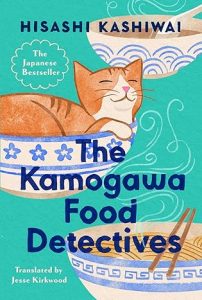 Murder in Highbury by Vanessa Kelly
Murder in Highbury by Vanessa Kelly Format: eARC
Source: supplied by publisher via Edelweiss
Formats available: hardcover, ebook, audiobook
Genres: cozy mystery, historical mystery, regency mystery
Series: Emma Knightley Mystery #1
Pages: 400
Published by Kensington on October 22, 2024
Purchasing Info: Author's Website, Publisher's Website, Amazon, Barnes & Noble, Kobo, Bookshop.org, Better World Books
Goodreads
The delightful debut of a Regency historical mystery featuring Jane Austen’s indefatigable Emma Knightley! Perfect for fans of Anna Lee Huber, Darcie Wilde, Claudia Gray, and Stephanie Barron. Less than one year into her marriage to respected magistrate George Knightley, Emma has grown unusually content in her newfound partnership and refreshed sense of independence. The height of summer sees the former Miss Woodhouse gracefully balancing the meticulous management of her elegant family estate and a flurry of social engagements, with few worries apart from her beloved father’s health . . . But cheery circumstances change in an instant when Emma and Harriet Martin, now the wife of one of Mr. Knightley’s tenant farmers, discover a hideous shock at the local church. The corpse of Mrs. Augusta Elton, the vicar’s wife, has been discarded on the altar steps—the ornate necklace she often wore stripped from her neck . . . As a chilling murder mystery blooms and chaos descends upon the tranquil village of Highbury, the question isn’t simply who committed the crime, but who wasn’t secretly wishing for the unpleasant woman’s demise. When suspicions suddenly fall on a harmless local, Emma—armed with wit, unwavering determination, and extensive social connections—realizes she must discreetly navigate an investigation of her own to protect the innocent and expose the ruthless culprit hiding in plain sight.
My Review:
Mrs. Elton was dead, to begin with. And the only person in Highbury who seems to miss her is the local vicar. Then again, that local vicar was her husband, so he’s supposed to miss her. even if the woman had earned the, let’s call it the disregard, of everyone else in town – one way or another.
Honestly, several ways and many others. Mrs. Augusta Elton believed that everyone in Highbury was beneath her, and wasn’t at all shy – in any way – about making that plain.
When her body is discovered on the floor of her husband’s church, with finger-shaped bruises around her neck, blood and brain matter matted in her hair but without the expensive necklace she habitually wore, it’s clear to even the dullest numpty that Mrs. Elton was murdered. Also robbed, but definitely murdered.
The problem in Highbury is that there hasn’t been a murder in decades – and the local coroner and constable ARE both a couple of utter numpties at best, and pompous, self-aggrandizing fools at worst.
However, the corpse of the late, unlamented was discovered by Mrs. Knightley – the former Miss Emma Woodhouse – and her friend Mrs. Martin, the former Miss Harriet Smith. And, while Harriet can be a bit of a widgeon when she’s upset – and discovering a dead body is certainly VERY upsetting – Emma is much too intelligent and level-headed to let the terrible sight in front of her prevent her from investigating the scene of the unprecedented crime.
And Emma Knightley, née Woodhouse, has never, ever been a dullard or a widgeon or a numpty. So, when most of the officials involved in investigating the case – with the obvious exception of Emma’s dear husband, who was, after all, smart enough to marry her in spite of her errors in matchmaking in the Jane Austen book named after her – accuse an oh-so-obviously incorrect person of the murder, Emma is all in on investigating the crime herself.
With, or without, her husband’s approval. But generally – and thankfully for Emma’s wake – with. Allowing Emma to prove, yet again, that there are times when she can be just a bit TOO smart for someone’s own good. And very nearly, her own.
Escape Rating A-: I was honestly surprised at how very much I enjoyed Murder in Highbury. But enjoy it I certainly did, and kept coming back to it over the course of a lazy Sunday because I just couldn’t resist seeing both whodunnit and how Emma managed to investigate the case in spite of a lack of even any of Sherlock Holmes’ forensic methods.
 Part of my trepidation was due to not being an Austenphile. I’m pretty sure I listened to Emma once upon a time, but that would have been 30 years ago. I don’t remember any of the details – but that did not affect my enjoyment of this story one bit. (If you never read Emma, or read it LONG ago and don’t remember those details either, I would recommend looking at a plot summary. The events are still relevant, and the players are the same, so some background is helpful but not required.)
Part of my trepidation was due to not being an Austenphile. I’m pretty sure I listened to Emma once upon a time, but that would have been 30 years ago. I don’t remember any of the details – but that did not affect my enjoyment of this story one bit. (If you never read Emma, or read it LONG ago and don’t remember those details either, I would recommend looking at a plot summary. The events are still relevant, and the players are the same, so some background is helpful but not required.)
The second part of my concern going into the story reflects back on yesterday’s book (and Friday’s a bit, come to think of it), in regards to the difficulty that frequently occurs in female-led historical fiction. Specifically that the protagonist needs to be a woman of her own time and not ours, but must manage to realistically have enough agency to BE the protagonist. Emma manages to walk that line differently from Mabel Canning of the London Ladies’ Murder Club a century later, but manage it she does.
It helps that Emma was known to be high-handed, headstrong and intelligent if often prone to rushing down the wrong path, and she’s still that a year later in this story. Howsomever, while she is not independent in the way that Mabel is, she is allowed to act according to her own nature by the men who do have actual power over her – so she frequently acts first and worries about questions of forgiveness vs. permission later if at all – even as she still sometimes lets her heart overrule her head.
Because we’re in Emma’s head, we get to experience both what is said and done on the outside, as well as her actual, and frequently much less socially acceptable, thoughts on the inside. The men in charge absolutely ARE idiots, and we get to cringe right along with her.
Above all, and in spite of the murder, or on top of it, underneath it and all around it, Murder in Highbury is still just the kind of ‘comedy of manners’ that infused Jane Austen’s work and has made it utterly timeless. Human nature hasn’t changed in a mere two centuries, and the exposure and gentle ribbing of the nature of people in Highbury rings true in spite of the murderer and his (or her!) victim in their midst.
Or perhaps even more so because of it. Making Murder in Highbury a surprisingly charming and utterly delightful read. It looks like Murder in Highbury is the first in a cozy historical mystery series. I hope so, because I’d be delighted to return to Highbury to watch Emma investigate another case!

 The Booklover's Library by
The Booklover's Library by  Escape Rating B: I picked up The Booklover’s Library because I was fascinated by the concept AND because I enjoyed the author’s earlier book,
Escape Rating B: I picked up The Booklover’s Library because I was fascinated by the concept AND because I enjoyed the author’s earlier book, 
 Fangs So Bright & Deadly (Mythwoven, #2) by
Fangs So Bright & Deadly (Mythwoven, #2) by  Escape Rating A: The fun thing about this series so far is the way that it manages to take the formulas for urban fantasy and paranormal romance – formulas that are tried and true and familiar – and make them fresh and new by adding in the panoply of mythical creatures and legends from places that weren’t touched on back in urban fantasy’s heyday AND then combining those legends with romantic possibilities that just weren’t publishable back then.
Escape Rating A: The fun thing about this series so far is the way that it manages to take the formulas for urban fantasy and paranormal romance – formulas that are tried and true and familiar – and make them fresh and new by adding in the panoply of mythical creatures and legends from places that weren’t touched on back in urban fantasy’s heyday AND then combining those legends with romantic possibilities that just weren’t publishable back then. The Crescent Moon Tearoom by
The Crescent Moon Tearoom by  First, I loved the setting. Chicago is still one of my favorite cities, and it’s always seemed magical to me. Part of the reason I loved the
First, I loved the setting. Chicago is still one of my favorite cities, and it’s always seemed magical to me. Part of the reason I loved the  What We Sacrifice for Magic by
What We Sacrifice for Magic by  Escape Rating B: If Hazel Beck’s
Escape Rating B: If Hazel Beck’s  Darkside (Planetside, #4) by
Darkside (Planetside, #4) by  Carl Butler has the worst best luck in universe. Or the other way around. He always gets his team out of whatever FUBAR situation he’s gotten them into. Then again, it’s a FUBAR situation that they’re in because FUBAR follows him around like a lost puppy that doesn’t seem to realize it’s already found a forever home.
Carl Butler has the worst best luck in universe. Or the other way around. He always gets his team out of whatever FUBAR situation he’s gotten them into. Then again, it’s a FUBAR situation that they’re in because FUBAR follows him around like a lost puppy that doesn’t seem to realize it’s already found a forever home. Escape Rating A: I got caught up in Carl Butler’s (mis)adventures back in the first book in this series,
Escape Rating A: I got caught up in Carl Butler’s (mis)adventures back in the first book in this series,  He’s a good man who does some very bad things – but tries to mitigate the damage whenever he realistically can. Which doesn’t mean he isn’t perfectly willing to ream EVERYNONE involved in this CLUSTERF*** a new one. Then again, they deserve it. And we’re right there with him hoping that they all get exactly what they deserve.
He’s a good man who does some very bad things – but tries to mitigate the damage whenever he realistically can. Which doesn’t mean he isn’t perfectly willing to ream EVERYNONE involved in this CLUSTERF*** a new one. Then again, they deserve it. And we’re right there with him hoping that they all get exactly what they deserve. One Big Happy Family by
One Big Happy Family by 
 The Restaurant of Lost Recipes (Kamogawa Food Detectives, #2) by
The Restaurant of Lost Recipes (Kamogawa Food Detectives, #2) by  Escape Rating A-: This is the series that got me firmly hooked on these cozy mystery/fantasy/magical realism type stories (the ones that trace their origin inspiration to
Escape Rating A-: This is the series that got me firmly hooked on these cozy mystery/fantasy/magical realism type stories (the ones that trace their origin inspiration to  Murder at King’s Crossing (Wrexford & Sloane, #8) by
Murder at King’s Crossing (Wrexford & Sloane, #8) by  The difference between “I’ve got a bridge to sell you” and “I’ve got revolutionary plans for building bridges to sell you” should be the width of a chasm – but it’s not nearly as far as one would expect in this latest entry in the
The difference between “I’ve got a bridge to sell you” and “I’ve got revolutionary plans for building bridges to sell you” should be the width of a chasm – but it’s not nearly as far as one would expect in this latest entry in the  Escape Rating B: It took the longest time for this particular entry in the series to grab me. Once it finally did, I was hooked again, but it took longer than usual. It was probably a combination of not being quite the right book at the right time, the domesticity of the early scenes (which I love but not quite so thoroughly front-loaded) AND the fact that the characters were flailing around to get even a glimpse of a direction for a bit longer than is usual for this generally über-competent crew.
Escape Rating B: It took the longest time for this particular entry in the series to grab me. Once it finally did, I was hooked again, but it took longer than usual. It was probably a combination of not being quite the right book at the right time, the domesticity of the early scenes (which I love but not quite so thoroughly front-loaded) AND the fact that the characters were flailing around to get even a glimpse of a direction for a bit longer than is usual for this generally über-competent crew. Fear the Flames (Fear the Flames, #1) by
Fear the Flames (Fear the Flames, #1) by